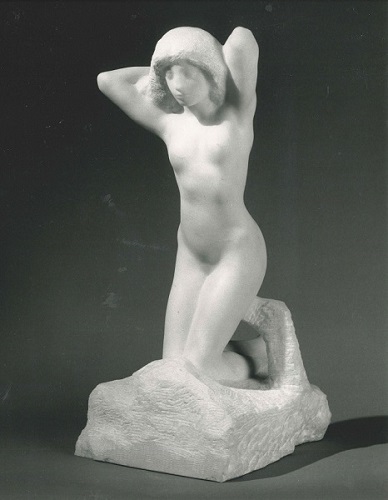
Auguste Rodin
French, 1840-1917
Kneeling Caryatid, 1900
marble
24 x 12 in.
SBMA, Gift of Patricia Wash Eaton orris in memory of Mary Halliday
1991.123

Undated photo of Rodin
"I choose a block of marble and chop off whatever I don't need." - Auguste Rodin
RESEARCH PAPER
By the year 1900, Rodin had a greater interest in rendering his models in marble than he did in in bronze. He could achieve a greater likeness to firm flesh in the luminous and near translucent qualities of the polished, fine white marbles. There also was his realization that stone did not need to be deeply scored to achieve the variety of tonal qualities that are accomplished from reflected light on it. Gentle mounds and delicate ridges were his new voice. He could reveal the feminine form with greater sensuality by using this medium over all the others in which he worked. It seems that he most successfully portrayed the subject of the form of young women by using marble.
The KNEELING CARYATID is a fine example of Rodin's ability to simulate flesh and project the voluptuousness of a young female body. With proper lighting, this figure seems to become a live and pulsing maiden. Unlike the partially robed and majestically posed ancient Greek sculptures, this compact kneeling nude brings youth and joy into the room. This scupture of almost translucent, milky-white stone was metamorphosed into a sensuous state of flesh by the finesse of a master's skill. On close examination of this kneeling young woman, one is amazed that although the feet are crossed, right over left, she is still able to maintain such balance and extension of the upper body. Her elbows are lifted around her head as her hands slide under the long hair to lift it off the back of the neck. The back is shaped in a gentle "s" curve. What is remarkable as well is the shallow carving of the face, as if just suggesting the delicate features. As a contrast to the silky smooth texture of her skin, her hair and the pedestal are rendered as coarsely scored surfaces. There is also the unusua feature in a Rodin sculpture in the addition of a short, narrow support to this figure from the base and attached to the left hip. The proportion and balance of the various parts of the body are lifelike and natural--different from his bronzes.
Rodin's marbles may lack the fire of emotion or challenge the imagination like his bronzes do, but they certainly are a reflection of his maturity and skill. He had reached a more tranquil, Autumn phase of life, and his finesse in modeling imbued his young women with an erotic sensuality and beauty not seen in his earlier bronze works. This serenity seemed to be the calmness after the storms of his youth. These marble sculptures give the illusion of youthful energy and freedom, yet the figures, similar to some by Michelangelo, are somehow still bound to the stone from which they are emerging. Like the humans they represent, they affirm the ever-present fact that no one achieves complete freedom. Rodin's art of his turbulent youth, as well as the art of his old age, influenced future artists like, Lipchitz, Brancusi, Duchamp-Villon, Giacometti, and others to seek truth and to assert their individual expression in their work.
Prepared by Eunice Drell for the Docent Council, July 2003
